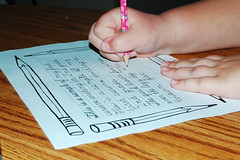Between ages 8 and 10, children’s academic skills (see full Glossary) are developing and improving quite dramatically. They are now reading and writing, and for the most part they are enjoying it. They delight in their ability to read new and complex books, books without pictures, and even read stories to their younger siblings. At school, they are engaging in science experiments (Fig. 1) and going on field trips where they learn a lot about the world they live in. They become more and more independent, though they continue to need reminders to do their homework.
Figure 1. Science experiment
READING
Most children this age:
- read quite fluently, and for fun;
- have a large vocabulary of sight words (see full Glossary);
- guess the meaning of an unknown word from the context most of the time;
- retell complex stories with a high degree of accuracy;
- self-correct, when reading;
- increase the size of their vocabulary, almost on a daily basis;
- can summarize what they have read;
- identify nouns, verbs, adjectives and adverbs in sentences;
- use the dictionary.
WRITING
Most children at this age:
- write long correspondence (Fig. 2);
- write quite legibly;
- spell familiar and unfamiliar words;
- use punctuation to add meaning to sentences (for example, an exclamation point);
- self-correct their writing;
- may start to write poems;
- can copy from a blackboard;
- may start to write letters in cursive (Fig. 3);
- may start to write email or text messages to their friends, and may even have a Facebook page.
Figure 2. Correspondence
Figure 3. Cursive writing
MATH
Most children at this age:
- add three and four digit numbers;
- subtract three and four digit numbers;
- use money correctly;
- know how coins and paper bills are connected (Fig. 4);
- calculate ahead of time how much a cashier will give them back in change;
- tell time with both digital and analog clocks (Fig. 5);
- measure in many ways (for example, using tape measures, containers, etc);
- read a thermometer;
- know basic multiplication;
- start to learn about division;
- compare numbers (which is bigger, which has more);
- understand and use simple fractions;
- know the difference between a shape and a solid (i.e. shapes are 2D and solids are 3D);
- use basic statistical language (for example, “more likely to happen,” “less likely to happen”);
- solve complex word problems ;
- count down from two digit numbers (for example. 99, 98,97…).
Figure 4. Coins and paper bills
Figure 5. Analog clock
Did you know?
Grade 4 is considered a transitional stage in the development of a child’s reading skills. It is described as the grade in which the shift from “learning to read” to “reading to learn” occurs.




